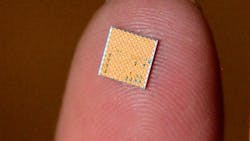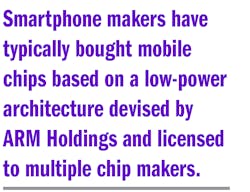Over the last year, Intel cleaned the slate after failing to sell computer processors at the heart of smartphones. The company ended its mobile processor line, announced around 12,000 layoffs to focus on cloud computing and connected devices, and made wireless modems for smartphones a new priority.
Now the Santa Clara company is starting 2017 with an aggressive step to build up its modem business. At the International Consumer Electronics Show in Las Vegas, Intel revealed plans to sell a new modem chip for handling 5G wireless communications. Samples will be available starting in the second half of this year, said the company's executives.
Aicha Evans, Intel’s vice president of communications and devices, said that the modem chip will deliver downloads around 5 gigabits per second, making it around five times faster than the latest wireless modems and 20 times speedier than the most advanced 4G networks.
The announcement makes Intel the latest chip maker to release 5G hardware even though the wireless standard is far from set in stone. Wireless companies are still hammering out the final version of the technology, which will connect smartphones and other gadgets to 5G networks. Widespread 5G networks are still years out, but the first networks are not expected until 2020.
Verizon has promised to open preliminary 5G networks as soon as this year, and South Korea carriers are trying to deploy networks by 2018. That's because 5G technology will provide major improvements over current wireless technology. For instance, it will allow smartphone users to browse the internet and stream videos much faster and with fewer interruptions.
But device manufacturers need special hardware to tap into them.
Intel is not the only companies working to etch 5G features into silicon. In October, Qualcomm revealed its own 5G modem called the X50, which it said would sample in the second half of 2017 and first appear in products in 2018. The modem will operate around 5 gigabits per second, Qualcomm executives said at the time.
That performance could be critical to connecting delivery drones, virtual reality headsets, and billions of wireless sensors. These devices need networks that respond quickly and exchange reams of data with the cloud, where it can be pooled and processed by machine learning programs. Intel is the biggest supplier of server chips in data centers.
Intel's new chip, also known as Gold Ridge, contains features that are likely to be included in the final 5G standard. It is designed to coordinate multiple antennas, which shortens the time it takes for devices to send and receive messages, and to steer antenna beams electronically. It also has the ability to access higher frequency bands ignored by current wireless standards.
These features could help factory robots and autonomous cars to talk to each other wirelessly. Intel said that Gold Ridge is part of its new autonomous driving platform, which enables cars to share location information to help make snap decisions about avoiding obstacles. The chip could also send details about a car's surroundings to update online traffic maps.
In a blog post, Evans said that the chip would be used in early trial networks and “to lay a foundation enabling accelerated development of products” that support 5G wireless technology. The modem will grant devices access to a wide array of frequency bands that companies in United States, Europe, Korea and Japan are using in trials.
The chip will not only work in the lower frequency bands frequented by today's devices but also the higher millimeter wave bands, which are largely unused for wireless communications and which the United States government has announced it will open up. It contains two transceivers that work in the 28 gigahertz band and frequency bands under 6 gigahertz.
Smartphone makers have typically bought mobile chips based on a low-power architecture devised by ARM Holdings and licensed to multiple chip makers. Qualcomm is one such supplier and it has dominated the market for smartphone chips and modems. Intel had little success until this year when it replaced some Qualcomm modems in Apple's new iPhone 7.
For now, Intel's 5G modem stands on uncertain ground with no definitive 5G standard. Like Qualcomm, it could have to modify the design to suit the final standard. It might not be as easy to redo as the 5G modem based on a field-programmable gate array that Intel deployed in trials a year ago and updated last August.
Its competitors are not staying quiet. Samsung has made progress in developing miniaturized antennas and power amplifiers for 5G base stations and smartphones. Mediatek, which has been trying to gain the clout of international firms like Intel and Qualcomm, has around 100 engineers working on its 5G technology, which it also sees as critical for automobiles.



